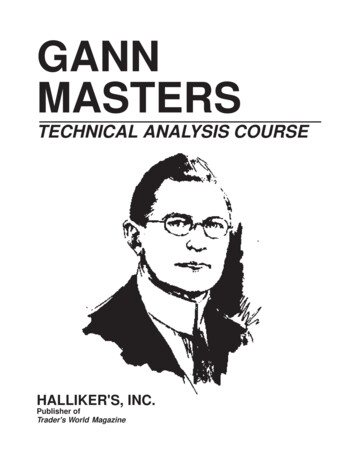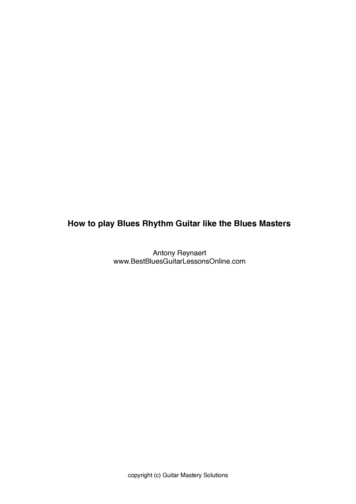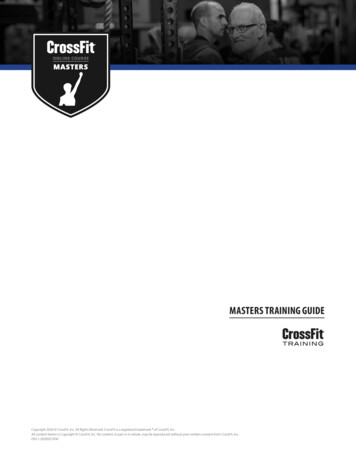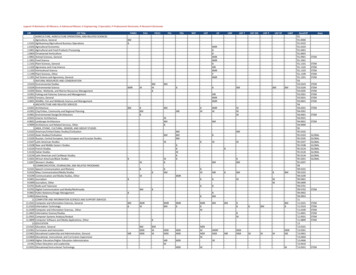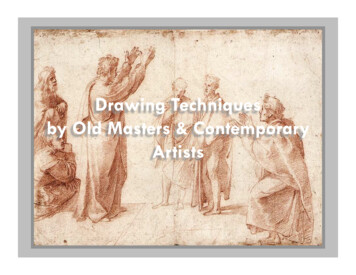
Transcription
Drawing Techniquesby Old Masters & ContemporaryArtists
A beautiful, sensuous surface is one of the principlegoals of meticulous drawing. For the past 500 years,certain artists in each era have maintained fine renderingand attention to surface as a priority in their work.Making these beautiful drawings requires different skillsfrom making good paintings. Many talented painters lackthe light touch and sensitivity to produce a sensuoussurface on paper. Perhaps the ultimate tool in themeticulous technique is a medium called "silverpoint".
The characteristics of silverpoint are:1) subtlety of tone in the lighter end of the tonal scale2) single-hatch drawing resulting in an extremely uniform,sensuous surface
Artists, whether Old Master or contemporary, whoare most successful in silverpoint drawing are thosewith a deep concern for beauty of surface. So anartist such as Leonardo, who was perhaps the mostsensitive draftsperson in all art history, is much moresuccessful in silverpoint than an artist such asMichelangelo who is relatively heavy-handed in hisdrawing.
The influence of the great Italian Renaissance artist Michelangelo spread far beyond his own time.His red chalk study for one of the figures on the Sistine Chapel ceiling is an extraordinary exampleof his conception of the idealized male nude. In making his drawing, Michelangelodepended both on the live model and on his understanding of the idealized anatomyof classical sculpture. Although the two poses are very different, both have forward curvingtorsos that emphasize the muscles of the chest and abdomen. The pose comes from a famousfragment of classical sculpture that both artists knew, the Belvedere Torso.Michelangelo Buonarroti (Italian, 1475-1564)Study for the Nude Youth over the Prophet Daniel, 1510-11Red chalk, 13 3/16 x 9 3/16 inches
Annibale Carracci understood this as well when he drew his figureof Hercules almost one hundred years later.Annibale Carracci (Italian, 1560-1609)Hercules Resting, 1595-97Black chalk heightened with white, squared in black chalk onright, 13 15/16 x 20 5/8 inches
Hatching is the repetition of parallel lines to create broad areas of tone, as we see in this detail of a leg in aMichelangelo figure drawing. In Cross hatching the artist adds another series of lines that cross the first set,creating even denser areas of tone, as seen in Dürer's arm of Eve.Michelangelo Buonarroti (Italian, 1475-1564)Detail from Study for the Nude Youth over the ProphetDaniel, 1510-11 (recto)Red chalk and black chalk on beige laid paper, 133/16 x 9 3/16 inchesFigure Studies for the Sistine Ceiling (verso)Red chalk heightened with traces of whiteAlbrecht Dürer (German, 1471-1528)Detail from Arm of Eve, 1507Point of brush and gray and black wash, brush andgray and black wash,heightened with white gouache,on blue laid paper, 33.4 x 26.7 centimeters
Made almost four centuries apart, these two sheets show how the tradition and function of drawingshas been continuous in the history of Western art. Durer and Degas both drew in order to understandhow to convincingly render the arm of a female figure they planned to use later in a finished oil painting.However, they used very different techniques to achieve this end.Both artists wanted to understand how light falls on a form and how to make it appear three-dimensional.Durer used a network of lines—known as crosshatching—made with the point of a brush.Degas, on the other hand, used black chalk, which he could blend to make subtle tonal variations.Albrecht Dürer (German,1471-1528)Arm of Eve, 1507Point of brush and grayand black wash,heightened with whitegouache, 13 1/8 x 10 ‡inchesEdgar Degas (French,1834-1917)Angel Blowing aTrumpet, 1857-59Black chalk, 17 æ x 2115/16 inchesGift of the Print Club ofCleveland 1976.130
Hatching: One of the mostcommon ways for an artist tosuggest volume and depth, or thedepiction of shadow, by whichclosely drawn parallel lines aregrouped together.LineHatchingIn the case of cross-hatching, theparallel lines are crossed by othersets of lines which create a densegrid-like pattern.Crosshatching
In this drawing, 18th century French painter JeanHonore Fragonard creates a beautifully sensuoussurface with the single-hatch technique.
Raphael’s drawingwith delicate combinationof lines and hatching.
Artists use a stump, a tightly rolled piece of leather or paper, to manipulate andblend dry media like chalk or charcoal. Piazzetta used a stump to vary the richblacks in this detail from a crayon drawing.Giovanni Battista(Giambattista) Piazzetta(Italian, 1682-1754)Detail from A YoungWoman Buying a Pink froma Young Man, about 1740Black crayon (wetted andrubbed) heightened withwhite chalk, on blue laidpaper (faded to greengray), 42.7 x 54.9centimeters
Wash is a general term that generally refers to diluted ink applied with a brush. In this detail fromGuercino's drawing of Venus and Cupid, the face of Venus shows how, by varying the density of thewash by varying his brushstroke, the artist achieved tonal gradation.Giovanni FrancescoBarbieri, called Guercino(Italian, 1591-1666)Detail from Venus andCupid, 1615-17Pen and brown ink andbrush and brown washover red chalk, on creamlaid paper, 25.5 x 39.4centimeters
As its name implies, metalpoint is a stylus made of metal that actually leaves small depositson the paper, which much be specially prepared so that it has a slightly rough surface.Metalpoint is made of several different soft metals, including gold, bronze, or, more commonly,silver. This drawing by Raphael on paper prepared with a pink ground is in silverpoint.Raffaello Santi, calledRaphael (Italian,1483-1520)Detail from Studies of aSeated Female, Child'sHead, and Three Studies ofa Baby, about 1507-8Silverpoint on cream laidpaper prepared with apink ground, 12 x 15.3cm.
Cortona's idealized head of a youth shows the extremely refined shading that is possible with blackchalk. Cortona used a combination of parallel hatching and stumping to achieve the fine gradations ofsurface tone that give this head three-dimensional volume.Pietro Berrettini, calledPietro da Cortona(Italian, 1596-1669)Detail from Study for theHead of St. Michael, 1633Black chalk on beige laidpaper, perimetermounted to cream laidpaper, 19 x 16.8centimeters Leonard C.
Red Chalk is a naturally occurring clay that gets its red color from iron oxide (hematite). It hasbeen popular since the Renaissance and can produce both sharp contours and delicate, smoothmodeling, as in this drawing by Jusepe de Ribera.Jusepe de Ribera(Spanish, 1591-1652)Detail from St. Sebastian,1626-30Red chalk with pen andbrown ink, on cream laidpaper, 17.3 x 12.4centimeters
The French term "Trois Crayons" (three chalks)refers to a technique using black, red, and whitechalk together to achieve a wide range of values,black being the darkest tone, red the middle tone,and white the lightest.This technique became especially celebratedin the drawings of Antoine Watteau, but thissheet is anexample by Watteau's mentor,Charles de La Fosse.Charles de La Fosse(French, 1636-1716)Detail from St. John theEvangelist, about 1700-2Black, red, and whitechalk on beige laidpaper, 42 x 26.2centimeters
This pen and ink drawing by Rembrandt shows theartist using hatching in a broad way. His marks arerelatively strong with the multi-directional strokesgiving a visual rhythm-rather than a refined continuoussurface--to the drawing.
Before metal was available, artists typically used quill pens made from bird feathers,and dipped the nubs in ink in order to draw.Pen lines can be loose and scratchy, as in the detail on the left, from a sheet by Fra Filippo Lippi,or careful and regular: in the next detail, we see how Degas tested his pen before he drew.Fra Filippo Lippi (Italian, about 1406-1469)Detail from The Funeral of St. Stephen, about 1460Pen and brown ink with brush and brown wash andtraces of stylus over traces of black chalk,on beige laid paper lined with cream laid paper,24.9 x 19.3 centimeters
Squaring allows an artist to transfer a design, square by square, from one surface to another.Varying the relative scale of the grids allows one to change the scale of the composition during transfer.We often see it on drawings used to plan larger compositions,as in this black chalk sheet byDomenichino.Domenico Zampieri,called Domenichino(Italian, 1581-1641)Temperance, 1628-30Black chalkheightened withwhite chalk, squaredwith black chalk, onfour sheets (joined)of light gray laidpaper, laid down oncream laid paper,perimeter mounted toa tertiary support oflaid paper, 59.2 x43.7 centimeters
These two sheets by the French rococo artist FranÁois Boucher show his early and latestyle of drawing. He made the fountain design toward the beginning of his career,using black and white chalk to create a decorative play of forms that follow theFrench style of ornament known as rocaille. The later drawing shows a looser technique,using pen lines and freely brushed ink washes. The artist drew it in preparation fora devotional religious painting that he never finished, and the sheet may havebeen one of the last works he completed before his death.François Boucher (French,1703-1770)Fountain with Two TritonsBlowing Conch Shells, about1736Black and red chalk andblack chalk wash,heightened with whitechalk, 14 13/16 x 8 11/16inchesFrançois Boucher (French,1703-1770)The Presentation in the Temple,about 1770Pen and brown ink, brushand brown wash, and blackchalk, heightened with whitepaint, 12 5/8 x 7 7/8 inches
Both of these drawings are examples of a practice exercise known as the "expressive head“(tête d'expression), in which the artist focuses in on the face and on how the features and musculature change with different emotions. The idea of studying expression developed in thelate 1600s with the French painter Charles Le Brun, who developed an entire system fordrawing different emotional states. The drawing shown here by Benjamin West was directlyinspired by Le Brun and is meant to represent "Terror." The red-chalk drawing by Greuze,on the other hand, is more psychologically subtle, representing a combination of shame and anger.Jean-Baptiste Greuze(French, 1725-1805)Head of Caracalla, about1768Red chalk, 15 º x 11 15/16inchesBenjamin West (American,worked in England, 1738-1820)Head of a Screaming Man, 1792Black crayon, 12 11/16 x 16 inchesDudley P. Allen Fund 1967.130.a
The representation of social class is often an important aspect of portraiture. Here, the French artistIngres shows the wealthy Madame Raoul Rochette looking comfortable in the height of fashion,with enormous "leg of mutton" sleeves, her hair tightly bundled at the top of her head in a styleknown then as an "Apollo's knot." Toulouse Lautrec's Laundress, on the other hand, is more aportrait of a type than an individual. She wears her hair in a similar way to Madame Raoul Rochette,but her slovenly appearance and weary demeanor suggest a life of difficult work.Jean-Auguste-DominiqueIngres (French, 1780-1867)Madame Désiré RaoulRochette, 1830Graphite, 12 5/8 x 9 7/16inchesHenri de Toulouse-Lautrec(French, 1864-1901)The Laundress, 1888Black and gray wash withwhite paint, scratchedaway in places, 29 7/8 x24 13/16 inches
This pair of drawings shows two artists' interest in images of everyday life (genre scenes),but their approaches are very different. Piazzetta suggests a narrative with the use ofjust a few props—a hat, a flower—and focuses on the scene in the way a film directormight use a close-up. The idealized youths engage us with their gestures and glances,but it is up to us to figure out the exact relationships among the three. Goya, on the other hand,presents a much more direct exchange—a young woman, clearly a prostitute,solicits the attention of a fat, ugly older man.Giovanni BattistaPiazzetta (Italian,1682-1754)A Young Woman Buying aPink from a Young Man,about 1740Black crayon heightenedwith white chalk, 1613/16 x 21 5/8 inchesFrancisco de Goya (Spanish,1746-1828)Prostitute Soliciting a Fat, UglyMan, 1796-97Brush and black and graywash, 9 º x 5 11/16 inches
Georges Seurat developed an incredibly refined style of drawing using the black, waxy crayon stickmanufactured by the ContÈ company. Whereas most artists use at least some line whendrawing with crayon or chalk, Seurat found a way to vary the pressure of the tool so that thetexture of the paper picked it up in different amounts.In this way he could develop subtle tonal effects. The special quality of light that results fromthis technique was something that Seurat's follower Charles Angrand well understood.Building on Seurat's technique, Angrand used it to make larger, more open compositionsand often explored rural subjects, like this harvest scene.Georges Seurat (French,1859-1891)Café-concert, 1887-88Conté crayon heightenedwith white chalk, 12 5/16 x9 ¼ inchesCharles Angrand (French,1854-1926)End of the Harvest, 1890sConté crayon, 19 3/16 x25 inches
Charles Angrand
Homer was one of the greatest practitioners ever of the watercolor medium, but his style andtechnique changed much over the course of his career.Boy with Anchor is an early work and belongs to a group he made in Gloucester, Massachusetts.Homer used graphite pencil extensively to make outlines of the composition, then filled in theseoutlines with brush and watercolor, so that they feel tight and linear, with areas of individual color.In the later work, a radical concept showing a fish caught in mid-jump over the surface of water,he used very freely brushed and blended watercolor washes,taking advantage of the fluid quality of the medium.Winslow Homer (American,1836-1910)Boy with Anchor, 1873Watercolor and gouachewith graphite, 7 5/8 x 133/4 inchesWinslow Homer (American,1836-1910)Leaping Trout, 1889Watercolor over graphite, 13æ x 19 7/8 inches
The female nude was a subject that fascinated the two towering figures of twe
The pose comes from a famous fragment of classical sculpture that both artists knew, . Both artists wanted to understand how light falls on a form and how to make it appear three-dimensional. Durer used a network of lines—known as crosshatching—made with the point of a brush. Degas, on the other hand, used black chalk, which he could blend to make subtle tonal variations. Albrecht Dürer .


